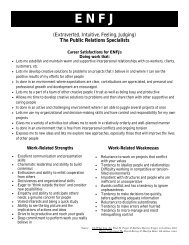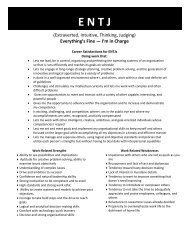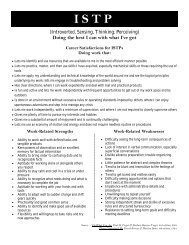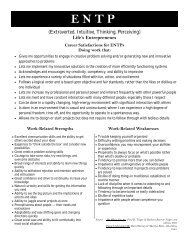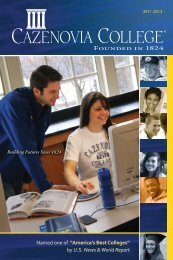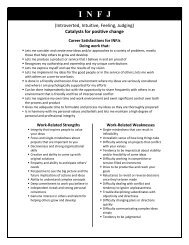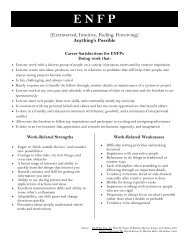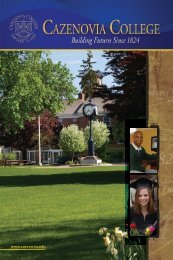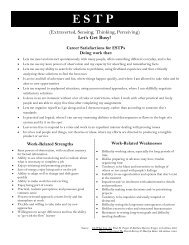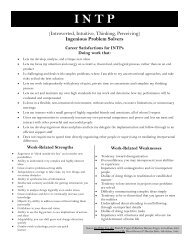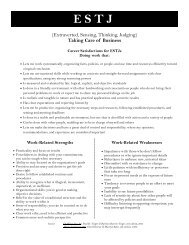of
2013-14 Academic Catalog - Cazenovia College
2013-14 Academic Catalog - Cazenovia College
- No tags were found...
Create successful ePaper yourself
Turn your PDF publications into a flip-book with our unique Google optimized e-Paper software.
Education Center to gain knowledge <strong>of</strong> equipment, inventory<br />
control, and budgetary aspects <strong>of</strong> this field in the equine<br />
industry. Students are required to complete a breeding lab<br />
analysis culminating in a breeding lab inventory project.<br />
(Offered spring term alternate years) Prerequisite: SM 215<br />
Equine Anatomy and Physiology, EQ 323 Equine<br />
Reproductive Management<br />
EQ 327 Breeding and Foaling Management I<br />
1 credit (CS)<br />
This course is a practical application course centered on the<br />
breeding <strong>of</strong> horses and foaling <strong>of</strong> mares. Students are<br />
required to participate in approximately 60+ hours <strong>of</strong><br />
experiences that may include: teasing mares, training stallions<br />
to the phantom, live cover breeding, collection <strong>of</strong> stallions,<br />
semen evaluation, artificial insemination, foal watch, and<br />
handling <strong>of</strong> foals. (Offered spring term) Prerequisites: SM<br />
215 Equine Anatomy and Physiology, EQ 323 Equine<br />
Reproductive Management<br />
EQ 330 Advanced Concepts and Methods in Horse<br />
Training<br />
3 credits (CS)<br />
A continuation <strong>of</strong> EQ 230 Concepts and Methods in Horse<br />
Training, this course further hones the student’s skills at<br />
developing abilities in the horse. Emphasis is placed on<br />
directing and modifying the response <strong>of</strong> a horse to a given<br />
cue. (Offered fall term) Prerequisite: EQ 230 Concepts and<br />
Methods in Horse Training, and permission <strong>of</strong> instructor<br />
EQ 335 Companion Animal Behavior<br />
3 credits (CS)<br />
This course involves the study <strong>of</strong> animal behavior as it relates<br />
to training and management <strong>of</strong> all animals, but with the<br />
largest portion <strong>of</strong> time spent on horses. The emphasis is<br />
placed on herd animal patterns, behavior in natural habitat<br />
and the adaptation techniques that the horse applies in<br />
artificial conditions. In addition, behavior patterns <strong>of</strong> other<br />
domestic animals such as dogs, cats and birds are discussed.<br />
(Offered on a rotating basis.)<br />
EQ 341 Techniques <strong>of</strong> Show Coaching<br />
3 credits (CS)<br />
The student learns the various aspects <strong>of</strong> coaching including<br />
preparation <strong>of</strong> horses and riders for participation in<br />
intercollegiate and USEF horse shows in the hunter, jumper<br />
and equitation divisions. Students wishing to specialize in<br />
other disciplines may likewise be accommodated. (Offered<br />
fall term alternate years) Prerequisites: EQ 241 Theory and<br />
Methods <strong>of</strong> Equitation I and EQ 242 Theory & Methods <strong>of</strong><br />
Equitation II, and/or permission <strong>of</strong> the instructor<br />
EQ 345 Therapeutic Riding Instruction<br />
3 credits (CS)<br />
Working with a local organization for riding for the physically<br />
and mentally challenged, students learn various techniques for<br />
teaching the challenged rider. This course requires additional<br />
outside time spent at an <strong>of</strong>f-campus facility. (Currently<br />
<strong>of</strong>fered on an independent basis.)<br />
EQ 426 Equine Medical Management<br />
3 credits (CS)<br />
In this practicum course, students gain valuable hands-on<br />
experience in the application and management <strong>of</strong> treatments<br />
and medications. The student is provided with the<br />
opportunity to assist a veterinarian; therefore, some field<br />
hours in addition to class hours are necessary. (Offered fall<br />
term) Prerequisites: EQ 321 Equine Diseases & Injuries I,<br />
and EQ 322 Equine Diseases & Injuries II<br />
EQ 401 Western Horsemanship IV<br />
2 credits (fulfills equitation requirement)<br />
Instruction includes refinement <strong>of</strong> position and schooling in<br />
the various forms <strong>of</strong> the gaits, riding ring etiquette and safety,<br />
increasing competency in pleasure, rail & pattern work, trail<br />
class work, western riding patterns and overall increasing<br />
competency in the western seat. More advanced riding<br />
theory, additional equipment usage for specific schooling or<br />
showing situations, patterns, and show ring procedures are<br />
included.<br />
A student may repeat this course once for credit. There is an<br />
additional fee for each course. (Offered annually)<br />
Prerequisite: Successful completion <strong>of</strong> two semesters <strong>of</strong> EQ 301.<br />
EQ 402 Hunter Seat Equitation IV<br />
2 credits (fulfills equitation requirement)<br />
Instruction includes schooling in the various forms <strong>of</strong> the<br />
gaits (working, “collected”, lengthened, “extended”), riding<br />
ring etiquette and safety, and development <strong>of</strong> competency<br />
and/or increasing competency in the hunter seat. More<br />
advanced riding theory, equipment usage for appropriate<br />
training, schooling or show ring situations, flatwork including<br />
refinement <strong>of</strong> longitudinal and lateral work to increase the<br />
horse’s training and physique, exercises over fences for the<br />
hunter, jumper or equitation horse as well as coursework and<br />
show ring procedures are included.<br />
A student may repeat this course once for credit. There is an<br />
additional fee for each course. (Offered annually)<br />
Prerequisite: Successful completion <strong>of</strong> two semesters <strong>of</strong> EQ 302.<br />
EQ 403 Dressage IV<br />
2 credits (fulfills equitation requirement)<br />
Instruction includes schooling in the ever continuing<br />
refinement <strong>of</strong> the dressage seat, schooling and enhancing the<br />
gaits and paces within the gaits (with emphasis on<br />
improvement by use <strong>of</strong> the training scale), figures,<br />
movements including USEF “First Level” and higher, lateral<br />
work, riding ring etiquette and safety, and increasing<br />
competency in dressage. More advanced work (medium gaits<br />
and more advanced lateral work) will also be included,<br />
dependent upon the progression <strong>of</strong> the rider and horses.<br />
Emphasis will be placed upon the logical sequencing <strong>of</strong><br />
movements in a training program, per the training scale and<br />
in the context <strong>of</strong> correcting individual training issues<br />
exhibited by the horses. In most cases students will have one<br />
horse as a training project for the semester. Show ring<br />
procedures are included.<br />
A student may repeat this course once for credit. There is an<br />
additional fee for each course. (Offered annually)<br />
Prerequisite: Successful completion <strong>of</strong> two semesters <strong>of</strong> EQ 303.<br />
Academic Catalog | Cazenovia College | www.cazenovia.edu 157



